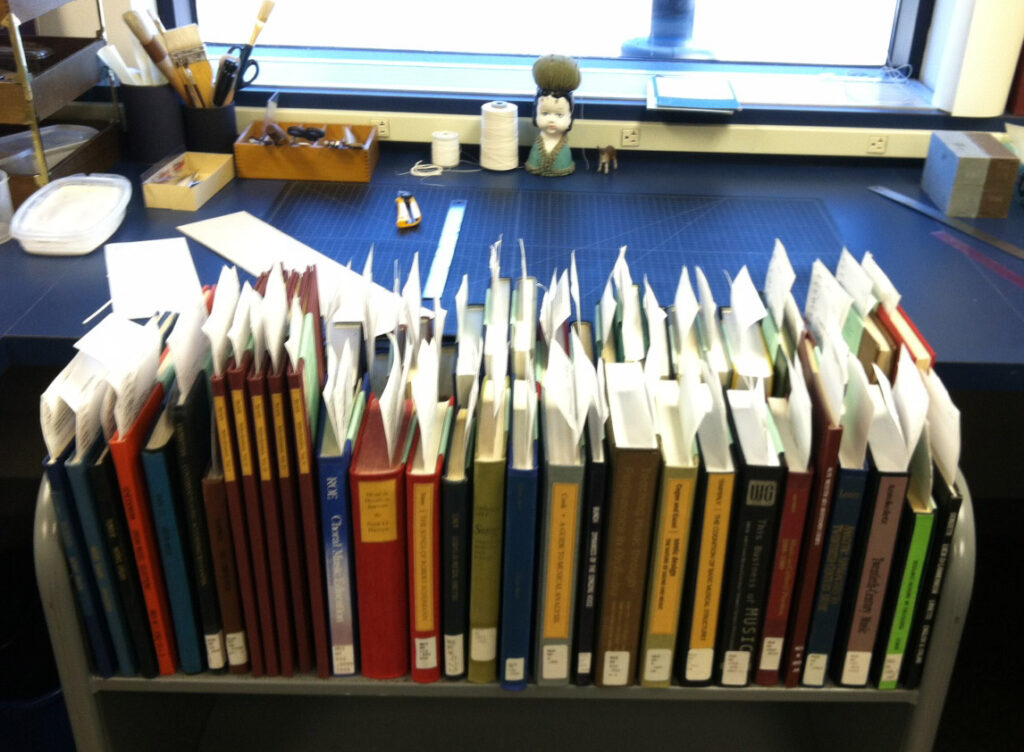It started normally enough in May, as soon as Spring semester ended. As part of a larger effort to enhance services for the William & Gayle Cook Music Library, we began a blitz of their heavily used Reserves Collection.
The Jacobs School of Music at IU has one of the largest academic music libraries in the world, and we in General Collections Conservation can attest to the collection’s heavy and intensive use. Unlike some other disciplines, where use of print continues to decline, music materials there are still heavily used in print form.
Our goal was to repair all the needy reserve materials before the start of Fall semester. Alexis Witt, Reserves Coordinator, identified materials in need of treatment, and sorted them into priority groups — needed for 1st summer session, 2nd session, or (potentially) fall semester. We worked on them accordingly.
Many items needed the advanced skills of our Conservation Technicians, Anitta Salkola-White and Lara Tokarski. I pitched in too, while our student techs helped keep up with the regular flow of materials from other libraries. In all we repaired about 150 Music Reserve items, and spent an average of 2.6 hours per item.

Now I’ll bet you’re thinking, “Wow, 2.6 hours per item. That’s a lot!”
And it is. That is what can happen when materials, such as those on reserve, can’t be spared long enough for commercial binding or in-house repair. If treatment services and turnaround time are not responsive to the needs of users, repairs may be put off too long, and there may be pressure to use expedient methods (i.e., tape) to keep books together for another circulation. The longer repairs are put off, the condition worsens, repairs take longer, they have to be off the shelves longer, the work piles up. Sort of a vicious cycle.
In addition, there are a lot of scores in the Music Reserves Collection, many on reserve almost constantly. These occupied most of our time! Musical scores are used in a very particular way, which results in damage to the text pages (rather than the cover or cover-to-text attachment). While performing, the musician turns the pages quickly, taking a hand off their instrument only briefly. You can almost feel the energy of this activity from the pattern of tears that results.

Multiple edge tears, usually at the bottom of the page, are common.

On older scores, breaks and tears often occur all along the inner margins. Many needed guarding of the folds throughout, or mending at the bottom 2-3 inches of every fold.
All of these kinds of tears are more troublesome when they have been patched with pressure-sensitive tape. Also, many of the multiple-signature scores we repaired were commercially bound in the 1960s and 1970s using stiff hinge cloth wrapped around the folds of the first and last signatures. The cloth forms a knife edge against which the pages break, one after another. While the content is in tatters, the covers of many of the commercially bound scores are still sound.

We returned about 10 heavily damaged scores to the Music Library without repair so they could decide whether to try to purchase a replacement copy. These were generally brittle, covered liberally in tape, and more than about 6 folios. Those in similar condition but fewer pages could often be repaired with a combination of scanned replacement pages and tape removal with a heated spatula/hot tacking tool (when tape was in the way of a repair, such as in the folds, or when an irregular tear has been misaligned, obscuring information).
This brief but intensive project has spawned some new ideas for meeting the challenges of caring for this large, important, and heavily used collection, and we are working now to put some of those into place. At the beginning of the post, I said that our goal was to finish the reserve repairs before the Fall semester. We actually finished in late July, which turned out to be a very good thing.
My New Friend Wei T’o
On Monday after the long Fourth of July weekend, we were just settling into a nice routine with the Music Reserves when we got the call. As mentioned in an earlier post, the Library at the Kinsey Institute for Research in Sex, Gender, and Reproduction discovered a leak from a drain pipe over its book stacks, affecting about 400 books. The leak probably started at the beginning of the three-day holiday, judging from the condition of the books when we got there. It happened to be over the part of the collection with books about sex in art and in the movies, so about 90% of them are heavily illustrated. You know what that means – lots of coated paper.
In my next post, I will talk about my new friend, old Wei T’o, and how we spent the rest of the summer together (and probably fall too).

Leave a Reply